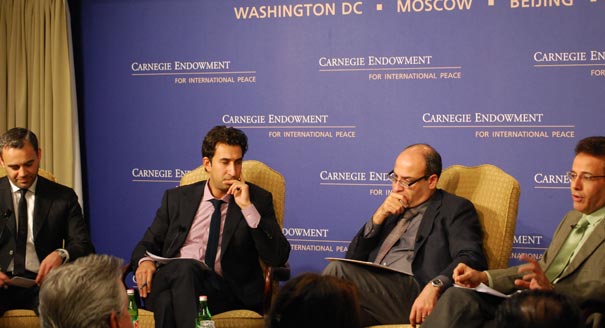Registration
You will receive an email confirming your registration.
Is the Islamic Republic of Iran a theocratic regime led by clerics, or a military dictatorship ruled by the Islamic Revolutionary Guard Corps (IRGC)? Ahead of the country’s March 2012 parliamentary elections, noted experts Mehrzad Boroujerdi of Syracuse University, Mehdi Khalaji of the Washington Institute for Near East Policy, and Ali Alfoneh of the American Enterprise Institute examined the evolving architecture of power in Tehran. Carnegie’s Karim Sadjadpour moderated the discussion.
Power in Iran
- Between Sultanism and Praetorianism: Boroujerdi outlined two views of power in Iran, which he described as Sultanism and Praetorianism. In the first view, Iran’s Supreme Leader Ayatollah Ali Khamenei holds all the power; in the second, the Islamic Revolutionary Guard Corps (IRGC) has all the power. He argued that power in Iran is actually somewhere between the two views: the IRGC has growing influence, but it is an exaggeration to say that they have taken over.
- Dominant IRGC: Alfoneh highlighted a number of trends that point to the dominance of the IRGC, including:
- War Veterans in Government: The election of President Mahmoud Ahmadinejad was the first time that a war veteran became president of the Islamic Republic. He added that of the 18 current cabinet ministers, 12 are former members of the IRGC or Basij militia.
- The Regular Military: While former IRGC members are playing a growing role in politics, there are still no representatives from the regular military in the parliament.
- Dual Role: IRGC plays a dual role of protecting the state from foreign interference and policing the state in order to sideline any domestic opposition.
- Weak Civilian Institutions: The civilian institutions in Iran are weak in comparison to the IRGC.
- War Veterans in Government: The election of President Mahmoud Ahmadinejad was the first time that a war veteran became president of the Islamic Republic. He added that of the 18 current cabinet ministers, 12 are former members of the IRGC or Basij militia.
- Reciprocity: It is best to characterize the relationship between Khamenei and the IRGC as a reciprocal relationship because while Khamenei is the commander of the IRGC, the IRGC is also the most important institution that supports the Supreme Leader, Khalaji argued.
Islamic Revolutionary Guard Corps
- Monolithic Institution: The IRGC is not a monolithic institution and does not speak with one voice, Boroujerdi stressed. Alfoneh demurred, however, arguing that the existence of different factions within the IRGC does not preclude the IRGC as an institution from being in power.
- Hybrids: Alfoneh stated that while there is a divide between the IRGC and the clerics, there are a number of “amphibious” politicians that are both clerics and IRGC alum.
- IRGC as a Political Party: Boroujerdi and Alfoneh agreed that, in Iran, the absence of a party system has enabled the IRGC to function as a political party.
- IRGC as an Economic Power: Over the last few years, the IRGC has taken advantage of the sanctions on Iran by signing a number of major contracts with Iran’s Oil Ministry when foreign companies are unable to compete, Alfoneh said.
- Agenda-setting Power: The IRGC has an agenda-setting power because they provide Khamenei with most of his intelligence and play a role in shaping his view, Boroujerdi added.
- Powerful Clerics: While the share of IRGC representation in every political institution in Iran has been increasing, the clerics also have a great presence in these institutions, Boroujerdi stated. In fact, he said, IRGC representation outnumbers that of the clerics only in the cabinet, and many clerics have been moved into more senior positions within the regime.
Clerical Class
Identifying a clerical class in Iran is complicated because a cleric can be defined by his studies, his dress, or his employer, Khalaji said. He added that the clerical establishment has no systematic relationship with the Iranian government, although individual clerics may.
Supreme Leader Ayatollah Ali Khamenei
- Supreme Strategist: Khamenei has outmaneuvered all of the other political actors in Iran, including the reformists, President Ahmadinejad, and other clerics, and is now in charge of a wide array of organizations that are beholden to him, Boroujerdi asserted.
- Veto Power: The IRGC has held veto power over the Supreme Leader since the era of Khomeini, Alfoneh argued. This creates an obvious limitation on Khamanei’s power.
- Succession: Khalaji said that his greatest concern for the future was not who would become the next Supreme Leader of Iran, but who would become the next commander of the IRGC, underlining his belief that the IRGC is the strongest institution in Iran and could survive a change to the political system in Iran.
U.S. – Iran Relations
Sadjadpour highlighted the fundamental differences in each panelist’s view of power in Iran and the implications of those positions on U.S – Iran relations:
- Engage with Khamenei: Boroujerdi believes that Ayatollah Khamenei is firmly in charge in Iran, and the U.S. administration has no choice but to engage with him directly.
- Engage with the IRGC: While Khalaji agrees that Ayatollah Khamenei is in charge, he argues that Khamenei cannot be engaged and any attempt to do so is an exercise in futility. Instead, he asserts that Washington should go over Khamenei’s head and engage with the leaders of the IRGC at the Supreme Leader’s expense.
- Khamenei a Figurehead: Alfoneh believes that Ayatollah Khamenei is essentially a figurehead for a regime controlled by the IRGC. Accordingly, Alfoneh argues that Iran will only respond to pressure.
